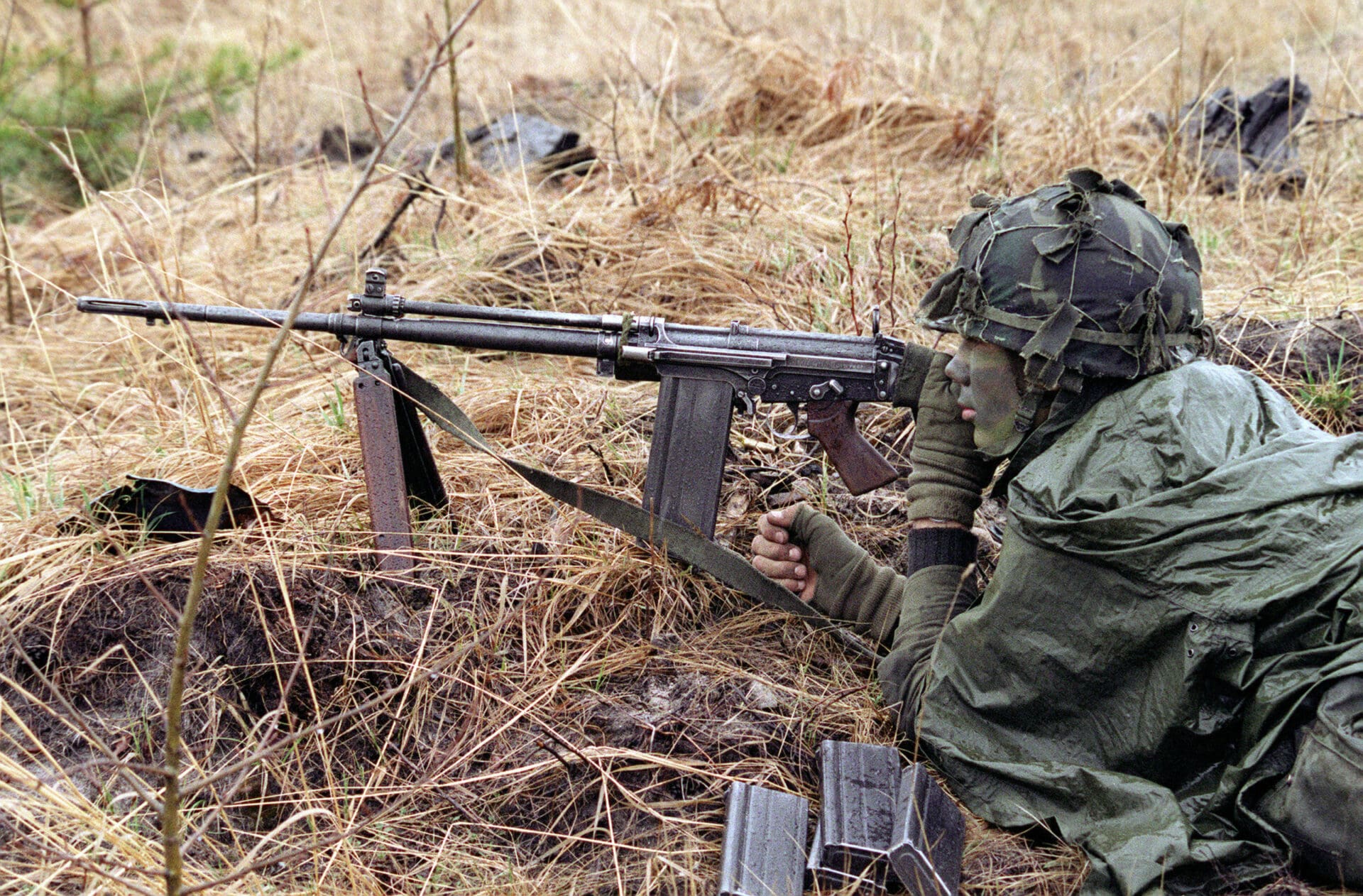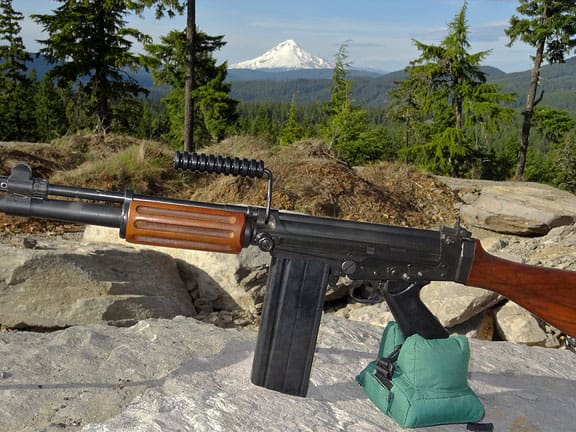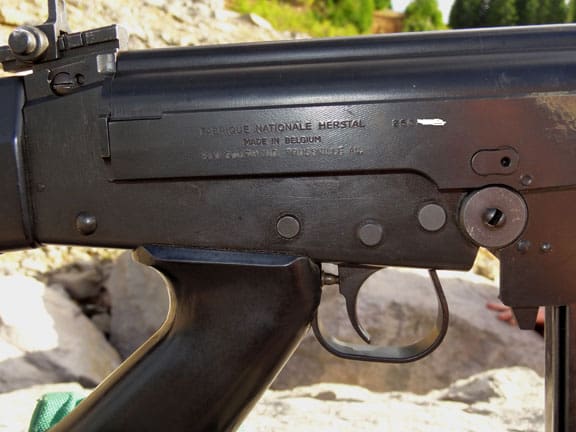
Most gun enthusiasts are familiar with the FN FAL, which has been widely imported into the United States. Excellent U.S. made clones are produced by DS Arms, and various other manufacturers have turned out parts-kit guns, too. However, less well-known is the fact that Fabrique Nationale d’Herstal, Belgium (aka “FN Herstal” or simply “FN”) manufactured a heavy-barreled version of the FAL known as the FALO.
Also known as the Model 50.41 or 50.42 (depending on the furniture), the term “FALO” is an abbreviation of the French name Fusil Automatique Lourd. While Browning BARs may be completely out of reach for most of us 99 percenters, semi-auto versions of the FN FALO can still occasionally be found at relatively reasonable prices at gun shows or Internet auction sites. And that makes the FALO an object of desire in my book.
The FN FALO was originally designed in the early 1960s for military use as a squad automatic weapon. Unlike the FAL, the FALO is equipped with a heavy tapered barrel, making it capable of producing accurate automatic fire at more prolonged rates than its little brother.
The concept of a lightweight, mobile squad automatic rifle began in 1918 with the legendary Browning Automatic Rifle (“BAR”). The post-WWI years saw the advent of many lightweight, magazine-fed machine guns suitable for the assault, including the Czech Vz 26, the French MLE 1924/29, the British Vickers-Berthier, the British Bren, the Japanese Type 96, and the German FG-42.
Most of these weapons were rather portly, though, weighing in the neighborhood of 22 to 28 pounds loaded. In contrast, the more modern FN FALO design tipped the scales at a mere 15 pounds loaded, representing a significant improvement in mobility over other designs.

The FALO was also unique in that it was the first of these designs to be adapted from the lighter infantry version of the rifle. Having both interchangeable magazines and increased parts interchangeability with the main battle rifle provided significant advantages in combat.
Nonetheless, while sales of the FN FAL were brisk in the 1950s through the 1970s, the FALO was only adopted by a few countries under license.
The FAL saw extensive action in conflicts all over the world, including Vietnam, the Cambodian civil war, Arab-Israeli Six-Day War, right up through the Falklands war, the Gulf War, both Chechen wars, and the Balkan wars. But not much appears to have been written about the combat history of the FALO. The British captured a number of Argentine versions in the Falklands War, and photos of Israeli troops using their licensed version can also be found.
The civilian version of the FN FALO is functionally and visually identical to its military big brother, except that it doesn’t have the giggle switch. It’s chambered in “.308 Match” instead of 7.62 x 51 NATO, which I understand to be a nod to laws that seek to discriminate in favor of weapons that have a “sporting purpose.”
Most of the civilian-legal versions were imported in the late 1970s and 1980s. I believe they were still imported up through the mid-1990s, but the MSRP increased dramatically due to bad exchange rates against European currencies.
Prices for the FALO have increased significantly over the years, especially for the 1800(+) samples of the so-called “sear cut” guns in civilian hands. Nonetheless, even non-sear-cut specimens in like-new to excellent condition will bring top dollar from FAL collectors; guns that sold for $2,000 in the past can easily command double that today.
Of course, that, and the current cost of ammunition, makes shooting this bad boy an increasingly questionable practice from an investment standpoint. But what the hell, it’s only rock and roll and I like it.
With a bit of practice, the FALO can be shot rapid fire in semi-automatic mode and keep all the rounds in a 5 to 6-inch circle at 100 yards.
Specifications: FN FALO
Weight: 6 kg (13.4 lbs)
Length: 1,150 mm (45 & 9/32 inches)
Barrel: 533 mm (20.8 inches), 4 groove, RH 1 in 12 twist
Cartridge: military version: 7.62x51mm NATO; civilian version: .308 Win with “match” chamber
Action: Gas-operated, short stroke piston, tilting breechblock
Muzzle velocity: 823 m/s (2,700 ft/s)
Effective range: 600 meters.
Feed system: 20, 25 or 30-round detachable box magazines
Sights: Aperture rear sight with 0-600 meter ramp adjustment, hooded post front sight








I remember when it not unusual to see these rifles, but like many semi-auto versions of military rifles that were once readily available at the time they have found their way into the hands of those who know what they have. They then almost never return to the market. I owned a FAL back in the ’80s and liked it very much. However, I never saw the point of an FALO that wasn’t full auto. Why carry the extra weight when there is no return?
!5 pounds for a semi auto? No. Now if it had the giggle switch……
Yep. I had one at one point awhile back, and sold it. I liked it but I could never get it to run reliably. I sold it and kind of regret it now, as now I would’ve been willing to pay someone with more knowledge then me to get it running right. I love battle rifles and so I then bought a G3, which is still my favorite rifle. Just a brute of a weapon. Glad I held on to that one.
Always liked the looks of this rifle. Didn’t know how heavy; that’s Barret territory.
When reminiscing and wondering where have all the good ol’ guns gone factor in bill clintoon and the ratbassturd who help concoct the 1994 Crime Bill. That ratbassturd would be your new (if you accept him as being legitimate) potus-“elect?” Jim Crow Gun Control joe biden.
Joe Biden’s walking corpse harks back only 30 years, but when he dies and Commie-la Whorish takes over, we’ll have “progressed” all the way back to Russia, circa 1917.
Meanwhile, the rest of us are keeping a wary eye on 1861 and 1776.
Everything old is new again.
Had a FAL in the late 80’s,the rifle from a accuracy stand point was not all that good in my book. It would group 3 to 4″ at 100 yds. with any of the 147 – 150 gr. ammo available,handload for it with 180 to 200 gr. bullets and it was a solid 1″ to 1 1/2″ performer, however I purchased it with 147 gr. to 150 gr. Mil Surp aka cheap at the time ammunition in mind as it’s daily food so I parted with it.
Green, that’s odd. Mine would shoot 1 1/2″ with any ball ammo I fed it. Two friends owned FALs at different times and their’s would do about the same.
I still have the FALO front end in the basement that I never installed- bbl and forend appear to be new. I built up a couple of those SARCO L1-A1 kits on Springfield Armory receivers back when they were around $150. I believe these came from Brit rifles shelled out after the Falklands deal- ugly hardware but mine would shoot well once I got everything square and dialed in. Those, and an SA 4800 “match” with the ridiculous “thumbhole” stock are still lying around in a safe somewhere and I ought to get them back out and shoot them sometime. I always liked the looks and handling of the FAL rifles. A lot easier to play with than an AR 10. although I’m sure that FALO front would change my opinion.
Is it just me or is a guy in green camouflage sitting in a patch of brown grass not very well hidden.
Seizure, guessing he’s in the military. If so, you wear what you’re issued.
I recently just picked up a DSA SA58 custom rifle that was made in 2000 and is is a great rifle to shoot.
The three I own will outshoot any of my M14’s.
Joe
Maybe it was different model but the locally made Australian Army L2A1 version was seventeen pounds unloaded plus 30 round magazine. Very forward heavy and unbalanced to carry.
The regular semi auto version balanced nicely.
I know someone who had a L2A1 back in the 1990s. They only ever took it to the range twice to my knowledge in 5 years. The handguard/bipod was interesting.
The FN FAL is no heavier than the Browning BAR M1918. Did soldiers get weaker after WW2?
No, but they now carry a ton more other stuff. Weapons/ammo may have gotten lighter but the soldiers of the world wars weren’t weighed down with tons of body armor, comms equipment, 40mm weapons/rounds, extra medical gear, a god knows what else the battalion commander has now deemed “part of the uniform.”
I read recently that the US soldier in the war on terror actually carried more weight himself then any soldier in all of human history. At least mideval knights were primarily on horseback and had squires.
“the soldiers of the world wars weren’t weighed down”
And yet, the Allies won. Remarkable!
Yes they have become weaker as has most of the populations of developed countries.
In most likelihood a grandmother of the 1800’s would probably win any arm wrestling match with most of the U.S. soldiers of today.
Ralph, the Browning M1918 BAR weighs around 21 pounds loaded. the FALO is much lighter!
“A Soldiers Load and the Mobility of a Nation”
5″-6″ rapid fire like in the video? That’s pretty useful I bet…for you know…things…
My range frowns on that kind of stuff, bullshit neighbors.
Shooting the neighbours would most likely cause more problems then it’s worth.
Burning their houses down would be a safer option and with a few cardboard signs and the right slogan, perfectly permissible.
“the FN FAL, which has been widely imported into the United States.” I have to take issue with that statement. Prior to Clinton ‘assault weapons’ ban just a hair over 2000 FN Herstal manufactured FAL’s were imported into the US and a similar number of FNC’s. If there’s something I don’t know please advise.
Had a SAR 48 shoot groups of 21/2 “ at 600 yards the draw back was it was difficult to get magazines for it it was sae not metric but was a great rifle of course our bullshit govenator would not be able to sleep 🛏
In the late 80’s I bought a new Belgian made FN FAL TYPE 50.00 Match imported by Gun South for $874.50. It likely was one of the 2000 that Roger J spoke of.
I wish I still had never sold it.
I still Have my 1980s Belgium Fn Falo 50.42 gun south it is still waiting to be fired .